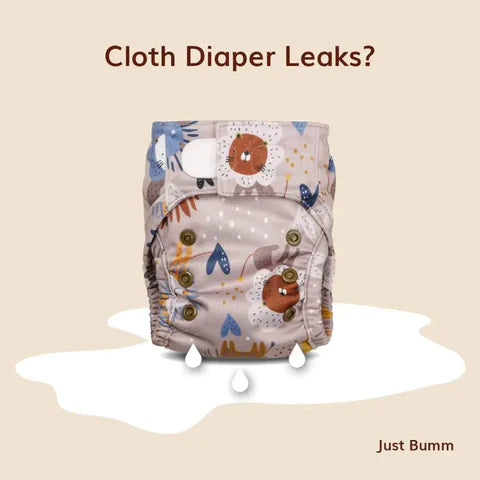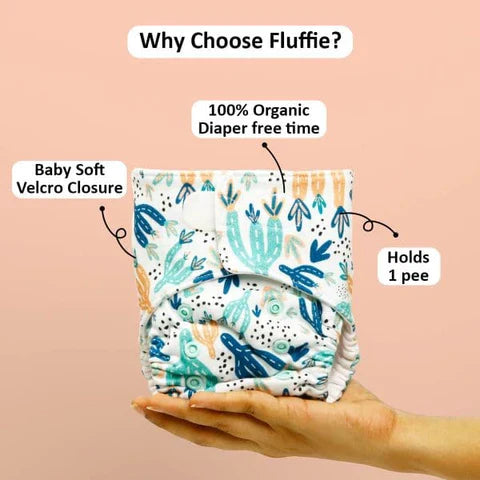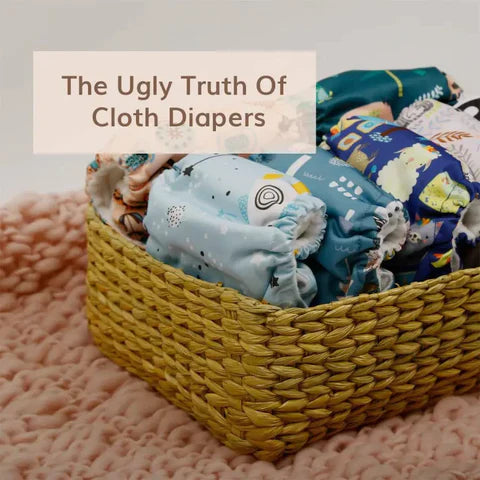Diaper leak is the main reason why you are hesitant to choose Cloth Diapers. Although leaks are common for all kinds of diapers. You need to consider many factors before concluding that cloth diapering is not for you. Your baby’s diaper may leak due to incorrect fit, absorbency, and much more. Continue reading to find out each type of leak and how you can stop them!

Check the Fit
Fit check is mostly overlooked with cloth diapers. Unlike taped or disposable diapers, you need to adjust cloth diapers well. Before you can leave it on your baby, double-check your fit! Loose fit causes leaks from all sides of the diaper. Size your baby’s diaper according to the weight chart!?. If the diaper is not snug enough, you will find gaps along the elastics. This will cause leaks when your baby pees. If you have sized the diapers correctly, yet the diaper leaks, you should tuck in the elastics properly. If you have used rise settings, tuck the fabric in the center upwards. This will help you reduce the gaps further and the diapers won’t sag anymore.
If the diaper leaks from the sides, check the gap at the tummy. Make sure that there is no more than two fingers gap. If you find leaks from the back side of the diaper, pull the diapers upward at the back. While you place the diaper below the baby, it should be right below the baby’s belly button. Improper fit is probably the only reason for diaper leaks if you are a new user and the diaper is brand new.
- How to Size Aurora Max and Dream Diapers – Watch Tutorial
- Learn to Size Newborn Diapers – Watch Tutorial
- Read tips and tricks for snug fit.
Try the ‘Move Up or Down the Rise’ hack
Your baby’s cloth diaper is in great condition, fit is correct, yet you see some leaks! Trust me, We all have been there! We do not know what causes these leaks and find ourselves fed up! Before you give up, always know that your baby is growing. Your baby gains or loses weight every day. They go through growth spurts and their weight changes. You must keep tabs on these little changes and adjust the rise setting accordingly. If the baby gains weight, you have to move up the rise.
During growth spurts, if your baby’s diaper becomes loose for the current rise, move down. There will be times when you will not know which hip button to snap on. We call it “in between buttons”. You will experience it at least once in your cloth diapering journey. Say for example, if you snap on the third button, it will be loose. But if you snap on the second button, it will be too tight. At such time, you can try changing the rise setting.
Increase Absorbency
Some time into diapering, you will find that babies do not have a regular wetting pattern. And it depends on various factors which keep changing. You have to increase absorbency if fit is not a problem. How to know that I need extra absorbency? You will know you need extra absorbency when the cloth diaper becomes full earlier than normal. And this will keep happening. If the insert has less number of layers that is no longer sufficient for your baby. Also during major changes such as weather, growth spurt, and food intake.
You might also want to consider this if your diaper is brand new or relatively new. There won’t be any chances of buildup unless you are following the right wash routine. If this is the case, you need to add extra absorbency to your baby’s diaper. You also have to consider other things like the material of the inserts you use. You are bound to face leaks if you use Microfiber, Bamboo, or Bamboo Charcoal inserts. These are synthetic and moisture-wicking materials that are prone to compression leaks. So if you have inserts made of these materials you should ditch them.
Inserts made of Organic cotton or hemp last longer and work better for you. If any of these are the cause of diaper leaks, add a booster to the insert you are using. Change inserts if they are made of Bamboo Charcoal (black) or microfiber. The following combos always work better if your baby is a heavy wetter. Organic Cotton Insert (10 or more layers) and Hemp Booster or Hemp Flat.
- Related Products: Accessories
Check your Wash Routine
Cloth Diapers will leak if you are not following the right wash routine. If you have been using cloth diapers for a while now, you need to recheck your routine. These are the things you need to consider while checking your routine for both machine/hand wash.
- How much laundry are you loading in your machine? Half load or Full load? Are you using the recommended amount of detergent based on your load?
- What mode are you running your laundry on? Are you using the right mode for your laundry?
- How long do you run your laundry or how long do you soak them?
- Is your detergent really working? If you get it out dull and yellowish and not fresh, it may not be.
- Is there enough agitation and plain rinse?
Using less detergent or more detergent will both lead to build up; Ammonia build up or detergent buildup. Your baby's cloth diapers will start showing signs early. You will find the diapers getting full earlier than usual – only if it is not because of changes in baby’s wetting pattern. You will observe stinks, and too many soap suds even after rinsing in plain water. Ruling out a perfect wash routine is not possible as every parent’s cloth diaper laundry load is different or not the same.
You have hard water!
Improper fit and wash routine is one thing that you can rectify on the go. But Hard water is another thing that would put you in a great dilemma. You don’t know what is happening to your diapers. Stinks, leaks, and inserts are very dull, it doesn’t absorb and leak. Diaper leaks due to hard water are very hard to identify if you are not aware of hard water issues. Hard water is high in dissolved minerals like Magnesium and Calcium. You can identify it by soap scum, white patches in household equipment. If you wash cloth diapers or any laundry in hard water, it won’t get cleaned well.
You will have to either install a water softening system for your house. Or Use water softener during washing in machines or by hand. If untreated, you will see the inserts turn yellowish, stinky, and less absorbent. It won’t absorb any more. You can also feel the inserts getting hard in the pee area. This is called Mineral Buildup. In such cases, you need to strip and bleach the diapers and accessories. Only then, your baby’s diapers will start absorbing.
It’s time to change the inserts!
If you have inserts like microfiber or bamboo, you need to change them ASAP to prevent rashes. The Insert fabric will start to degenerate if you have washed in hard water for a long time. If the inserts are beyond saving even with stripping, you should consider changing to new inserts. The normal life expectancy of cloth diaper inserts (Organic Cotton) is 2 years. Post which you can buy new inserts if you are thrifting or considering using them for a second baby.
It might be repulsion leaks!
If you have been using rash creams or moisturizers, it is possible that these leaks could be repulsion leaks. Petroleum-based products form a thin layer on the surface of the inserts or pads. As petroleum is not water-soluble, it becomes resistant to water and repulses it out. Hence you will notice your insert pads leak without even absorbing. You should always use a dry feel liner on top while using creams. In addition, you will also see a lot of stains from these products if you don’t use liners. These are the hacks you need to consider while checking for cloth diaper leaks! If you are not sure about what to do, click the below button and chat with us.
- Related Post: Are disposable diapers safe for babies?



Leave a comment
All comments are moderated before being published.
This site is protected by hCaptcha and the hCaptcha Privacy Policy and Terms of Service apply.